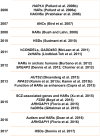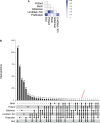Human Accelerated Regions and Other Human-Specific Sequence Variations in the Context of Evolution and Their Relevance for Brain Development
- PMID: 29149249
- PMCID: PMC5767953
- DOI: 10.1093/gbe/evx240
Human Accelerated Regions and Other Human-Specific Sequence Variations in the Context of Evolution and Their Relevance for Brain Development
Abstract
The review discusses, in a format of a timeline, the studies of different types of genetic variants, present in Homo sapiens, but absent in all other primate, mammalian, or vertebrate species, tested so far. The main characteristic of these variants is that they are found in regions of high evolutionary conservation. These sequence variations include single nucleotide substitutions (called human accelerated regions), deletions, and segmental duplications. The rationale for finding such variations in the human genome is that they could be responsible for traits, specific to our species, of which the human brain is the most remarkable. As became obvious, the vast majority of human-specific single nucleotide substitutions are found in noncoding, likely regulatory regions. A number of genes, associated with these human-specific alleles, often through novel enhancer activity, were in fact shown to be implicated in human-specific development of certain brain areas, including the prefrontal cortex. Human-specific deletions may remove regulatory sequences, such as enhancers. Segmental duplications, because of their large size, create new coding sequences, like new functional paralogs. Further functional study of these variants will shed light on evolution of our species, as well as on the etiology of neurodevelopmental disorders.
Keywords: deletions; duplications; genes; neurodevelopmental disorders; psychiatry; substitutions.
© The Author 2017. Published by Oxford University Press on behalf of the Society for Molecular Biology and Evolution.
Figures




References
-
- 1000 Genomes Project Consortium. 2012. An integrated map of genetic variation from 1, 092 human genomes. Nature 491:56–65.http://dx.doi.org/10.1038/nature11632 - DOI - PMC - PubMed
-
- Abdel-Mannan O, Cheung AF, Molnar Z.. 2008. Evolution of cortical neurogenesis. Brain Res Bull. 75(2–4):398–404. - PubMed
-
- Antonacci F, et al.2014. Palindromic GOLGA8 core duplicons promote chromosome 15q13.3 microdeletion and evolutionary instability. Nat Genet. 46(12):1293–1302.http://dx.doi.org/10.1038/ng.3120 - DOI - PMC - PubMed
-
- Asahara H, et al.2002. Dual roles of p300 in chromatin assembly and transcriptional activation in cooperation with nucleosome assembly protein 1 in vitro. Mol Cell Biol. 22(9):2974–2983.http://dx.doi.org/10.1128/MCB.22.9.2974-2983.2002 - DOI - PMC - PubMed
Publication types
MeSH terms
LinkOut - more resources
Full Text Sources
Other Literature Sources
Research Materials

